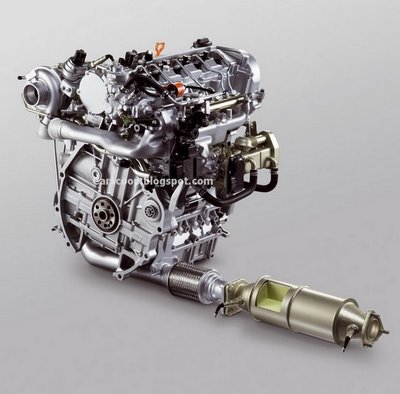 Thanks to revolutionary NOx catalytic converter that enables a great reduction in NOx emissions sufficient to meet stringent U.S. Environmental Protection Agency (EPA) Tier II Bin 5 emissions requirements, Honda is getting ready to import a revised version of its 2.2 CDTi diesel engine to the States within three years. The catalytic converter features an innovative system using the reductive reaction of ammonia generated within the catalytic converter to "detoxify" nitrogen oxide (NOx) by turning it into harmless nitrogen (N2).
Thanks to revolutionary NOx catalytic converter that enables a great reduction in NOx emissions sufficient to meet stringent U.S. Environmental Protection Agency (EPA) Tier II Bin 5 emissions requirements, Honda is getting ready to import a revised version of its 2.2 CDTi diesel engine to the States within three years. The catalytic converter features an innovative system using the reductive reaction of ammonia generated within the catalytic converter to "detoxify" nitrogen oxide (NOx) by turning it into harmless nitrogen (N2).Press Release : The new catalytic converter utilizes a two-layer structure: one layer adsorbs NOx from the exhaust gas and converts a portion of it into ammonia, while the other layer adsorbs the resulting ammonia, and uses it later in a reaction that converts the remaining NOx in the exhaust into nitrogen (N2). Ammonia is a highly effective reagent for reducing NOx into N2 in an oxygen-rich, lean-burn atmosphere. This ability to generate and store ammonia within the catalytic converter has enabled Honda to create a compact, lightweight NOx reduction system for diesel engines. The system also features enhanced NOx reduction performance at 200–300ºC, the main temperature range of diesel engines.
 Honda designed the catalytic converter for use with its 2.2 i-CTDi diesel engine, which has earned widespread praise for quiet, clean operation and dynamic performance since its introduction in 2003 on the European Accord model. By further advancing combustion control, the 2.2 i-CTDi delivers cleaner exhaust to the NOx catalytic converter. Honda achieved this by optimizing the combustion chamber configuration, reducing fuel injection time with a 2,000-bar common rail injection system and boosting the efficiency of the EGR (exhaust gas recirculation) system. Thanks to these improvements, Honda has reduced the amount of NOx and soot normally found in engine exhaust, while increasing power output.
Honda designed the catalytic converter for use with its 2.2 i-CTDi diesel engine, which has earned widespread praise for quiet, clean operation and dynamic performance since its introduction in 2003 on the European Accord model. By further advancing combustion control, the 2.2 i-CTDi delivers cleaner exhaust to the NOx catalytic converter. Honda achieved this by optimizing the combustion chamber configuration, reducing fuel injection time with a 2,000-bar common rail injection system and boosting the efficiency of the EGR (exhaust gas recirculation) system. Thanks to these improvements, Honda has reduced the amount of NOx and soot normally found in engine exhaust, while increasing power output.
Along with developing superior technology for cleaning exhaust gas, Honda plans to address other technical challenges in developing clean diesel engines, such as handling diesel fuels with different cetane numbers and meeting
Gasoline engines presently employ three-way catalytic converters that offer NOx reduction rates as high as 99%, but this performance is possible only at the stoichiometric air-fuel ratio. In the oxygen-rich environment of a lean-burn diesel engine, three-way catalytic converters only reduce NOx levels by approximately 10%. Honda's new catalytic converter efficiently reduces NOx in a lean-burn atmosphere, enabling diesel engines to rival gasoline engines in cleanliness. The compact system is also easy to install in passenger vehicles.
Technorati: Honda, 2.2i-CDTi, Diesel+Engines, ecology, green+cars, autos, auto+news, car+news, automobile, cars, automotive, vehicles
No comments:
Post a Comment